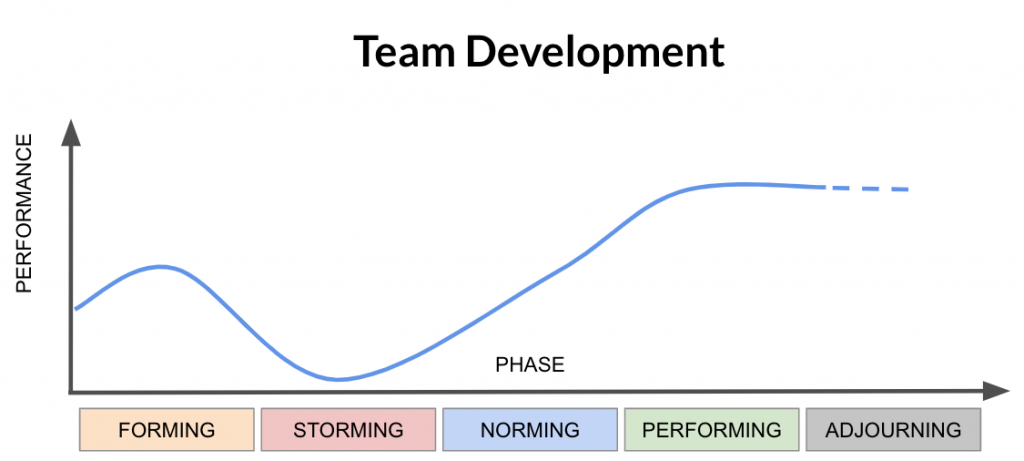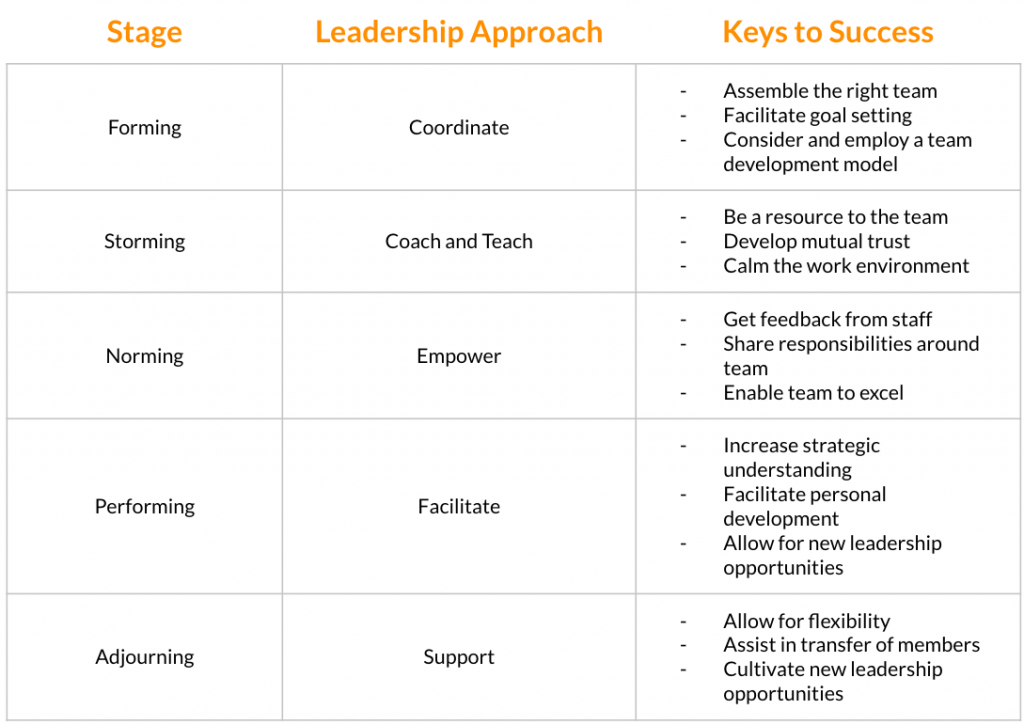Assembling a high performing team that delivers quality outcomes within tight timeframes requires some thought. Fortunately, there is a model for team development that will help you and your team tackle problems, develop healthy conflict, find better solutions, and, ultimately, grow together.
The model is called forming-storming-norming-performing-adjourning, developed by Bruce Tuckman in 1965 and then later extended in collaboration with Mary Ann Jensen in 1977. As a model it has stood the test of time. It remains one of the best frameworks and strategies for thinking about group dynamics and development, helping many teams come together and achieve quality results.

Each of these stages is expanded upon below.
Stage 1: Forming
In the Forming stage, the team is brought together and considers the work ahead of them. They learn about the challenges and opportunities of the work, agree on goals, and assign tasks.
Emotions
Emotions of team members are usually along the lines of excitement or anxiousness. Excitement about the goals they’re setting out to achieve, but anxiousness about how they will fit in or whether the team will perform.
Behaviours
As the team familiarises themselves with the work and each other, they are likely to use a considered and polite approach in their interactions. Team members may also act hesitantly—this is due to uncertainty in their role, their position (whether formal or not), and the interpersonal dynamics with others.
Tasks
The key tasks for team development in this stage are:
- Create and share structure, goals and roles.
- Share mission, context, and expectations.
- Establish processes and ways of working.
Stage 2: Storming
In the Storming stage, the team has been working together and is starting to sort itself out. Members will voice their opinions, question decisions, and make assessments of each other. People may feel that the team can’t reach its goals, or perhaps won’t work or perform in the way they expected.
This stage will likely come with some conflict, thus the name ‘Storming’. In Tuckman’s paper, 50% of the team’s studied had intragroup conflict. However, some teams also completely skip this stage.
If there is conflict, it shouldn’t be overly concerning. Sometimes conflict is necessary in order to work through differences and to develop communication skills and channels. Interventions can sometimes, counter-intuitively, be counter productive. Any disagreements must be resolved before the team can progress out of this stage.
Emotions
If this stage takes place, then emotions are usually along the lines of frustration or anger with the team’s performance, the leader, individual team members, ways of working, or the work itself.
Behaviours
Team members may argue or express frustration during this stage. Some may not participate to the extent that they are capable. In extreme cases, there may also be behaviours that undermine the team or actively work against it.
Tasks
The key tasks for team development in this stage are:
- Refocusing on goals, perhaps breaking the goals down into smaller steps.
- Re-evaluating ways of working.
- Redefining plans based on insights gained by the team.
Stage 3: Norming
In the Norming stage, with conflicts and disagreements now resolved, the team will find a spirit of cooperation. Working towards a common goal, all team members will be taking responsibility for their work, and be more tolerant of others in an effort to work together. There’s a danger in this stage that avoiding conflict will make people reluctant to share ideas.
Emotions
Through this stage, team members will feel energised and in harmony. A greater feeling of acceptance and belief in a common goal will give team members energy to work, as well as a deeper connection to their team members.
Behaviours
Team members will start to ambitiously work together to achieve the team’s goals. Roles and relationships will be more established, and big decisions can be made and implemented.
Tasks
The key tasks for team development in this stage are:
- Working together to achieve team goals.
- Optimising ways of working.
- Communication, collaboration, and harmony.
Stage 4: Performing
In the Performing stage, the team can start to reach an unexpectedly high level of success. Team members are both motivated and knowledgeable—their ability to autonomously work and handle big decisions keeps the team delivering quality outcomes.
Team supervisors are almost always participating in this stage. Changes to personnel or circumstances may cause a team to revert to an earlier stage.
Emotions
In this stage, team members feel confident and driven. By this point they feel competent doing their work, are driven to continue to make a valuable contribution to the outcomes of the team.
Behaviour
Team members will feel confident enough to express their opinions, leading to greater collaboration and investment in the team. Conflict will (and should) come up in this stage, but it will need to be in a form that the team finds acceptable. That might be a rigorous debate as long as there’s no yelling, or short, sharp feedback sessions that still acknowledge good intentions and good work.
Tasks
The key tasks for team development in this stage are:
- Continuing to achieve team goals and deliver strong outcomes.
- Having confidence in the efficacy of ways of working.
- Free expression of ideas.
Stage 5: Adjourning
As mentioned, the fifth stage of Adjourning was added by Tuckman and Mary Ann Jensen in 1977. This stage involves breaking up the team after the work is completed.
Emotions
In this stage, team members will feel closure and loss. If a team has successfully gone through the other stages of development, disbanding may create a sense of loss. People will often reflect on the value of their contribution to the team as a whole in this stage.
Behaviour
Team members move into different places or initiatives, and must remember their learnings from the completed project. Carrying these forward into new opportunities within a business will create a collective cultural memory, which will influence any newcomers into the organisation.
Tasks
The key tasks for team development in this stage are:
- Disbanding the team in a way that still retains knowledge—particularly of successful ways of working.
- Concluding the work in a way that brings closure.
- Maintaining relationships from the project.
Some considerations
A few thoughts to consider with the model:
- A team member joining or a change in leadership can send the team back to forming or storming.
- In software development, high performing teams will swarm as they come together. Swarming
Leadership Considerations by Stage
Below are some examples of leadership strategies to facilitate team development.

Additional Reading:
- Bruce Tuckman’s original paper
- Tuckman and Mary Ann Jesen’s expansion of the original model
- Another summary of the model.

Scott Middleton
CEO & Founder
Scott has been involved in the launch and growth of 61+ products and has published over 120 articles and videos that have been viewed over 120,000 times. Terem’s product development and strategy arm, builds and takes clients tech products to market, while the joint venture arm focuses on building tech spinouts in partnership with market leaders.
Twitter: @scottmiddleton
LinkedIn: linkedin.com/in/scottmiddleton